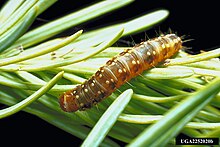| Choristoneura fumiferana | |
|---|---|

| |
| Choristoneura fumiferana caterpillar | |
| Scientific classification | |
| Domain: | Eukaryota |
| Kingdom: | Animalia |
| Phylum: | Arthropoda |
| Class: | Insecta |
| Order: | Lepidoptera |
| Family: | Tortricidae |
| Genus: | Choristoneura |
| Species: | C. fumiferana
|
| Binomial name | |
| Choristoneura fumiferana | |
| Synonyms | |
| |
Choristoneura fumiferana, the eastern spruce budworm, is a species of moth of the family Tortricidae native to the eastern United States and Canada. The caterpillars feed on the needles of spruce and fir trees. Eastern spruce budworm populations can experience significant oscillations, with large outbreaks sometimes resulting in wide scale tree mortality. The first recorded outbreaks of the spruce budworm in the United States occurred in about 1807, and since 1909 there have been waves of budworm outbreaks throughout the eastern United States and Canada. In Canada, the major outbreaks occurred in periods circa 1910–20, c. 1940–50, and c. 1970–80, each of which impacted millions of hectares of forest. Longer-term tree-ring studies suggest that spruce budworm outbreaks have been recurring approximately every three decades since the 16th century, and paleoecological studies suggest the spruce budworm has been breaking out in eastern North America for thousands of years.
Budworm outbreaks can have significant economic impacts on the forestry industry. As a result, the eastern spruce budworm is considered one of the most destructive forest pests in North America, and various methods of control are utilized. However, the species is also ecologically important, and several bird species are specialised on feeding on budworms during the breeding season. Several theories exist to explain the cyclical budworm outbreaks.